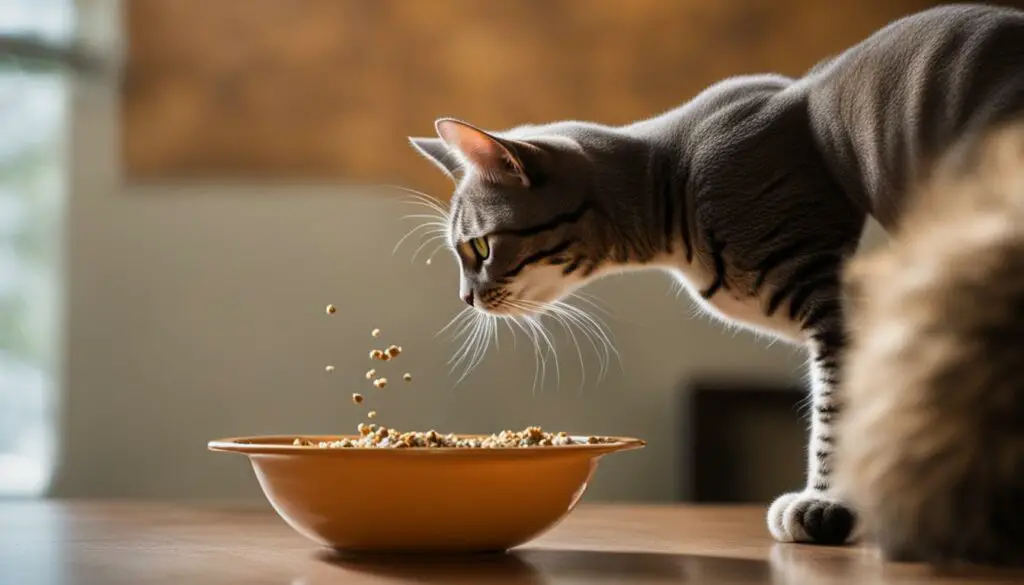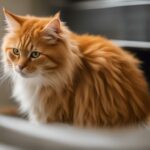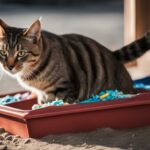If you’ve ever walked into your kitchen and found your cat’s poop in their food bowl, you’re not alone. This baffling behavior can leave cat owners scratching their heads in confusion. But fear not, I’m here to shed some light on why your furry friend may be exhibiting this unusual behavior.
Cats are known for their quirky habits, and pooping in the food bowl is no exception. There could be several reasons behind this behavior, ranging from marking behavior to underlying health issues. It’s important to understand the potential causes and take appropriate action to resolve the issue.
Key Takeaways:
- Pooping in the food bowl can be a marking behavior or a sign of territorial dispute.
- Health issues, such as urinary blockage, should be ruled out by consulting a veterinarian.
- Litter box-related factors like cleanliness and training can also contribute to this behavior.
- Changes in the environment, daily routines, or stress can trigger inappropriate elimination.
- Addressing the cat’s scent and sensory preferences can help prevent this behavior.
Possible Marking Behavior
If your cat is pooping in the food bowl, it could potentially be a form of marking or a territorial dispute. Cats may engage in this behavior to assert dominance over resources like food. It is also possible that there is a territorial dispute between multiple cats in the household. Increasing the number of resources available to the cats and providing separate food and water bowls may help alleviate this behavior.
During marking behavior, cats deposit feces in prominent areas to communicate their presence and establish territory. This can be a way for cats to assert dominance over resources, including their food bowl. A territorial dispute between multiple cats in the household can also lead to inappropriate elimination in the food bowl. In such cases, the dominant cat may purposefully defecate in the food bowl to assert its ownership.
Cats often use marking behavior to establish territory or communicate their presence. If your cat is pooping in the food bowl, it may be a way for them to assert dominance over resources. It’s important to address this behavior by increasing the number of resources available to the cats and providing separate food and water bowls to reduce any territorial disputes.”
Understanding Dominance and Resource Guarding
Marking behavior in cats can be related to dominance and resource guarding. When a cat marks its territory, it is staking a claim to the resources within that area. By defecating in the food bowl, a cat is essentially saying, “This is mine.” It may be an attempt to establish dominance over other cats in the household or to prevent them from accessing the food.
| Signs of Marking Behavior: | Signs of Dominance and Resource Guarding: |
|---|---|
|
|
If your cat is exhibiting marking behavior or dominance-related issues, it is important to address these underlying causes. Providing each cat with their own set of resources, including separate food and water bowls, can help reduce the need for marking and minimize territorial disputes. Additionally, implementing positive reinforcement techniques and interactive play sessions can help redirect their focus and establish a more harmonious relationship between cats.
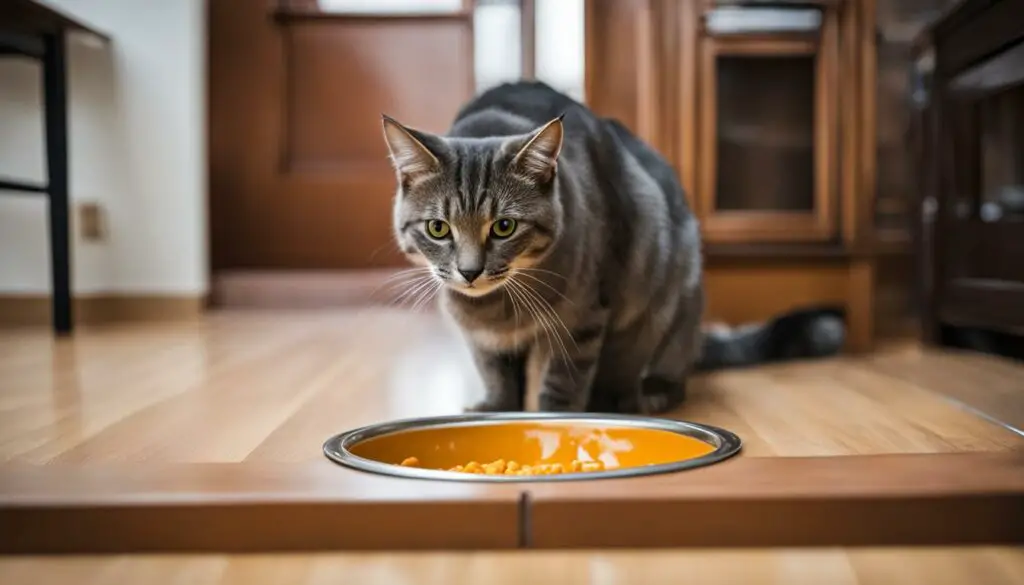
Considering Illness
When a cat starts pooping in its food bowl, it’s crucial to consider the possibility of underlying illness. This behavior may be a sign of a medical issue that requires veterinary attention. If your cat is also exhibiting other symptoms such as urinating outside the litter box, having difficulty producing urine or stool, or showing signs of distress, it is important to seek veterinary attention immediately. These symptoms could indicate a life-threatening urinary blockage or another serious medical issue.
A visit to the veterinarian is essential to rule out any health conditions that may be contributing to the inappropriate elimination behavior. The vet will be able to perform a thorough examination and run necessary tests to identify any potential medical issues. By addressing the underlying illness, you can help alleviate the cat’s discomfort and prevent further instances of pooping in the food bowl.
It’s important to note that cats may not always show obvious signs of illness, so it’s crucial to pay attention to any changes in your cat’s behavior or litter box habits. Regular check-ups with a veterinarian can help monitor your cat’s health and detect any potential issues early on. Preventive care and early detection are key to maintaining your cat’s overall well-being and preventing future instances of inappropriate elimination behavior.
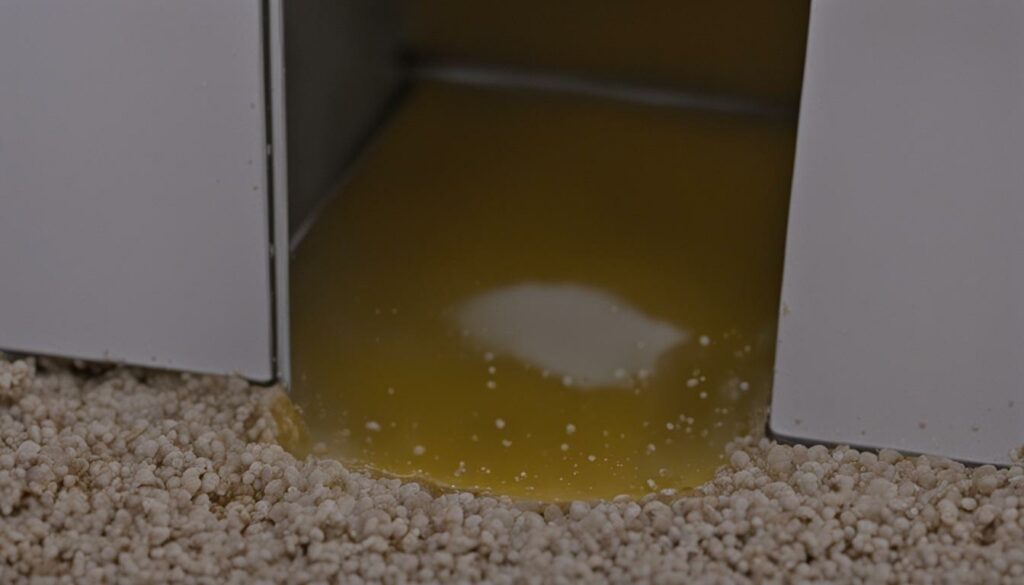
Litter Box-related Factors
When it comes to addressing a cat’s inappropriate elimination behavior, it is essential to consider the various litter box-related factors that may be contributing to the problem. These factors include the size of the litter box, its cleanliness, the avoidance of the litter box, and the need for proper litter training.
Litter Box Size
The size of the litter box plays a crucial role in a cat’s willingness to use it. Cats need enough space to comfortably enter, turn around, and dig. If the litter box is too small, it may cause discomfort and discourage them from using it. It is recommended to provide a litter box that is at least one and a half times the length of the cat from the tip of its nose to the base of its tail.
Litter Box Cleanliness
Cats are known for their cleanliness, and they prefer a clean litter box. If the litter box is dirty or has a strong odor, cats may avoid it and choose alternative places to eliminate. It is important to scoop the litter box daily and replace the litter regularly to maintain cleanliness. Additionally, avoid using harsh cleaning products that may leave behind strong fragrances that can deter cats.
Litter Box Avoidance
In some cases, cats may avoid using the litter box due to previous negative experiences or associations. For example, if a cat has been startled or frightened while using the litter box, it may develop a fear or avoidance response. To address this, it is important to create a positive and safe environment around the litter box. Placing it in a quiet and low-traffic area can help reduce stress and encourage regular use.
Litter Training
Proper litter training is essential for cats, especially those that are new to the household or have previously had litter box issues. It involves guiding the cat to the litter box, allowing it to explore and become familiar with the litter, and rewarding them for using it. Litter training may require patience and consistency, but it can significantly improve a cat’s litter box habits.
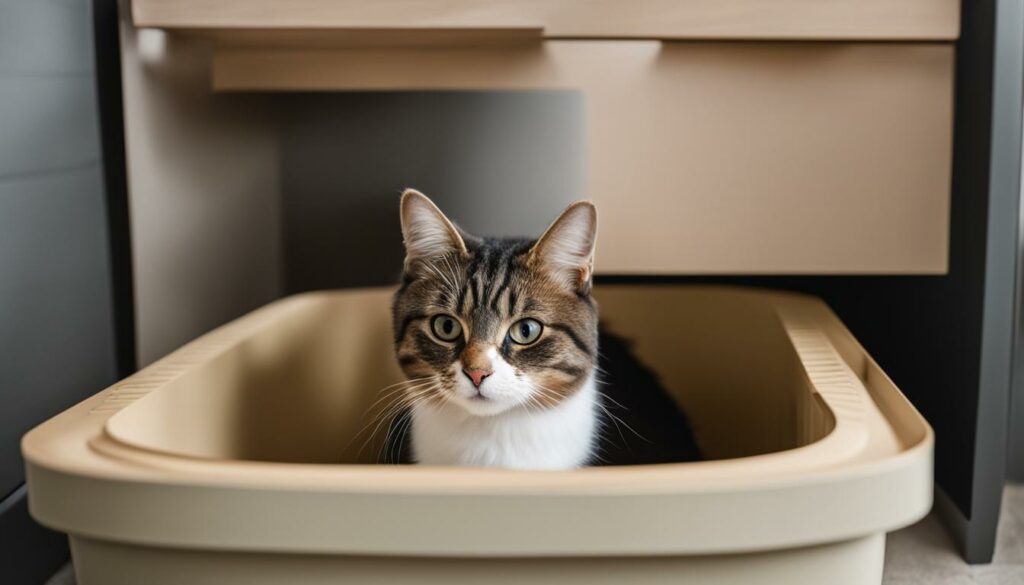
Environmental Factors
When addressing the issue of inappropriate elimination in cats, it is important to consider the influence of environmental factors. Changes in the house, such as the introduction of a new pet or alterations in daily routines, can cause stress and anxiety in cats. This, in turn, can lead to inappropriate elimination behaviors, including pooping in the food bowl.
Cats are creatures of habit and thrive on consistency. When their environment undergoes significant changes, they may feel unsettled and insecure. This can disrupt their normal toileting routine and result in them seeking alternative locations, such as the food bowl, to relieve themselves. To prevent this behavior, it is important to minimize environmental changes as much as possible and provide a stable and predictable routine for your cat.
Location of the Litter Box
The location of the litter box can also play a role in a cat’s toileting behavior. Cats are instinctively cautious animals and prefer to eliminate in areas that they perceive as safe and secure. If the litter box is located in a noisy or high-traffic area of the house, your cat may feel anxious or vulnerable while using it. This can lead to avoidance behaviors and inappropriate elimination elsewhere, including the food bowl.
To encourage your cat to use the litter box consistently, it is important to choose a quiet and secluded location that offers privacy. Avoid placing the litter box near loud appliances, in areas with frequent foot traffic, or near your cat’s food and water bowls. Creating a peaceful and easily accessible litter box area can help reduce stress and promote appropriate elimination behaviors.
| Environmental Factors | Impact on Toileting Behavior |
|---|---|
| Changes in the house | Can cause stress and anxiety, leading to inappropriate elimination |
| Location of the litter box | If noisy or unpleasant, can deter cats from using it and result in inappropriate elimination |
| Daily routines | Inconsistency can disrupt a cat’s toileting routine and lead to seeking alternative elimination spots |
| Stress | High-stress levels can trigger inappropriate elimination behaviors |
By minimizing changes in the house, ensuring a quiet and accessible location for the litter box, and maintaining consistent daily routines, cat owners can help create an environment that promotes proper toileting behavior. However, if the inappropriate elimination persists despite addressing these environmental factors, it may be necessary to seek professional help from a veterinarian or an animal behaviorist for further guidance.
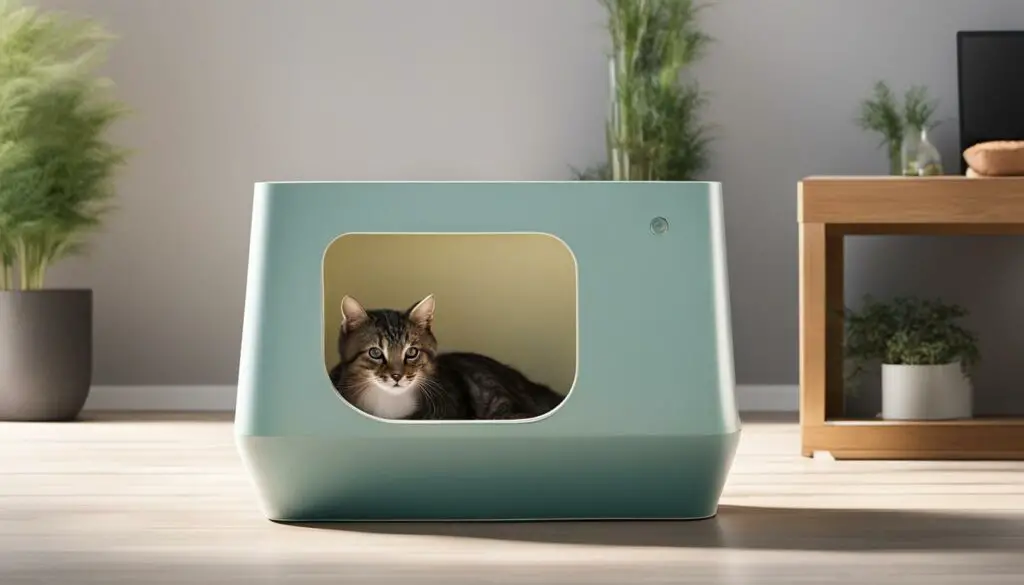
Scent and Sensory Preferences
Cats are known for their finicky preferences when it comes to scents and sensory experiences. They have a highly developed sense of smell and can be easily deterred by offensive scents. If your cat is pooping in its food bowl, it may be due to an unpleasant odor in the surrounding area. Additionally, the location of the litter box can also play a role in this behavior. Cats may avoid using a litter box located in a noisy or stressful area of the house, leading them to seek alternative elimination sites, such as the food bowl.
To address this issue, it is important to ensure that the litter box is located in a quiet and secure location, away from any offensive smells. The litter box area should be kept clean and free from any debris or waste. Cats also have preferences when it comes to the type of litter they use. Some cats may prefer a certain texture or scent of litter, such as finely ground granules. Experimenting with different types of litter can help determine your cat’s preferences and encourage them to use the litter box.
Additionally, providing a pleasant sensory experience in the litter box area can help prevent inappropriate elimination. This can include placing the litter box in a well-lit area, providing a comfortable and soft surface for your cat to stand on while using the litter box, and ensuring that the litter box is large enough for your cat to move around comfortably. By addressing your cat’s scent and sensory preferences, you can create a positive and inviting environment that encourages proper elimination behavior.
| Scent and Sensory Preferences Guidelines |
|---|
| Ensure the litter box is located in a quiet and secure area |
| Keep the litter box clean and free from any offensive smells |
| Experiment with different types of litter to find your cat’s preferences |
| Provide a well-lit and comfortable litter box area |
| Ensure the litter box is large enough for your cat to move around comfortably |
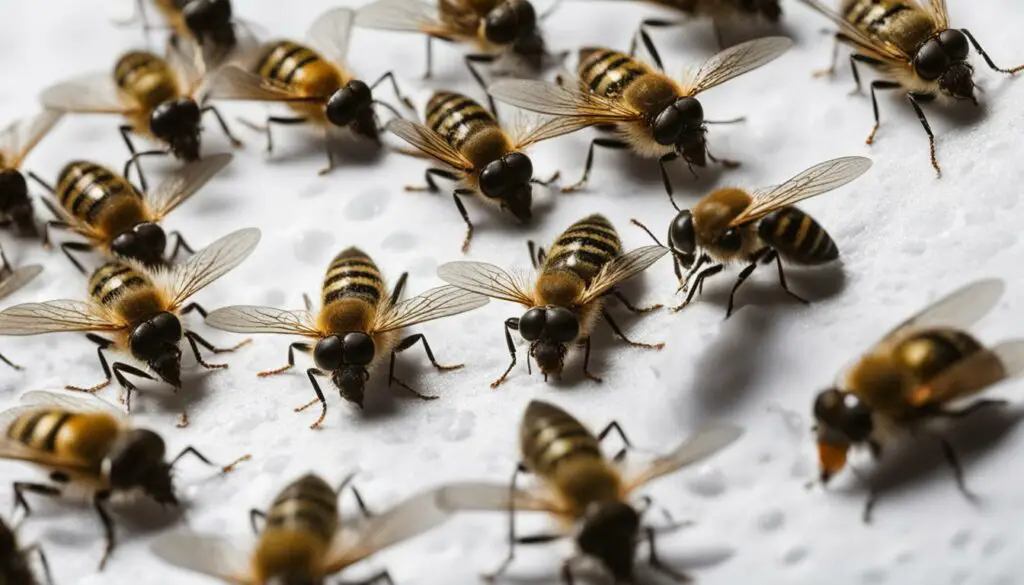
“A cat’s sense of smell is highly sensitive, and they can be easily deterred by offensive scents. It is important to address any unpleasant odors in the litter box area to encourage proper elimination behavior.” – Dr. Jane Thompson, Veterinary Behaviorist
Anxiety and Stress
Managing anxiety and stress in cats is crucial when addressing inappropriate elimination behaviors. Just like humans, cats can experience anxiety and stress due to various factors, including changes in their environment, the presence of other pets, or separation anxiety. Implementing anxiety-reducing techniques can help create a calm and reassuring environment for your feline companion.
One effective technique is providing hiding spots or safe spaces where your cat can retreat to when feeling anxious. These spaces can be as simple as cardboard boxes or dedicated cat condos. Interactive toys and puzzle feeders can also help alleviate stress by providing mental stimulation and distraction.
Additionally, maintaining a consistent daily routine can help reduce anxiety in cats. This includes feeding them at the same time each day, providing a designated playtime, and ensuring they have access to clean litter boxes. By establishing a predictable routine, your cat will feel more secure and less prone to stress-related behaviors.
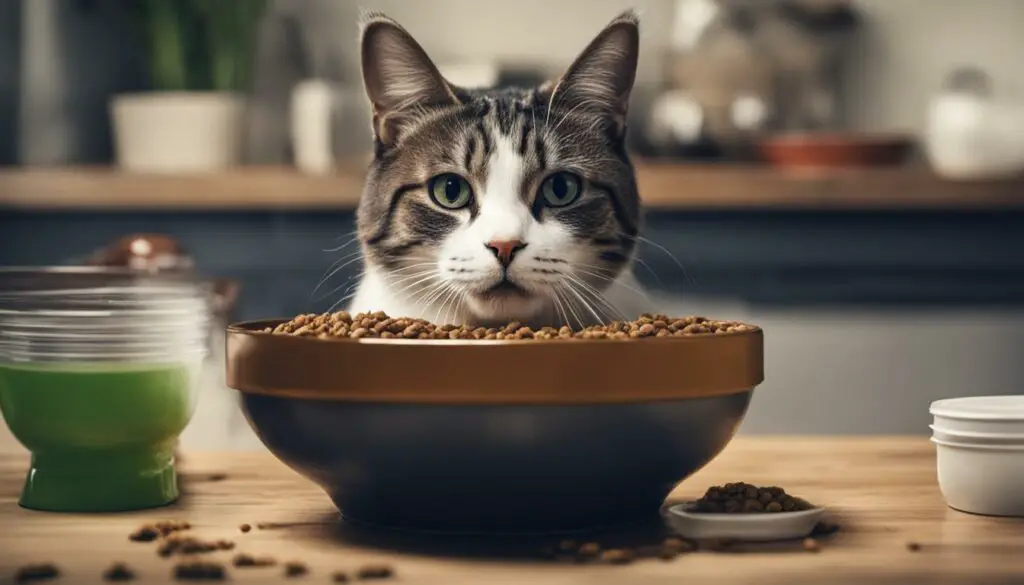
Quotes:
“Creating a calm and reassuring environment is essential when managing anxiety and stress in cats. By providing hiding spots and interactive toys, we can help alleviate their stress and create a sense of security.” – Dr. Emily Johnson, Veterinary Behaviorist
Anxiety-Reducing Techniques:
- Provide hiding spots or safe spaces
- Use interactive toys and puzzle feeders
- Maintain a consistent daily routine
| Technique | Benefits |
|---|---|
| Providing hiding spots | Allows cats to retreat and feel safe |
| Using interactive toys | Provides mental stimulation and distraction |
| Maintaining a consistent routine | Creates a sense of security and reduces anxiety |
Multi-Cat Dynamics
In multi-cat households, inappropriate elimination behaviors can arise due to inter-cat dynamics. Cats may engage in bullying behaviors, guarding resources such as food or the litter box, which can lead to stress and inappropriate elimination. It is important to ensure that each cat has access to its own resources and provide enough litter boxes for the number of cats in the household to reduce these issues.
Table: Multi-Cat Resource Management
| Resource | Recommendations |
|---|---|
| Food | Feed cats in separate areas to avoid competition. Provide multiple feeding stations to prevent resource guarding. |
| Litter Boxes | Have one more litter box than the number of cats in the household. Place litter boxes in different locations to ensure accessibility. |
| Scratching Posts | Provide multiple scratching posts at various locations to prevent territorial disputes over scratching areas. |
Preventing Bullying
Cats may engage in bullying behaviors that can exacerbate inappropriate elimination. To prevent bullying, it is essential to create a harmonious environment for all cats. Here are some tips:
- Ensure each cat has its own space with hiding spots and resting areas.
- Provide plenty of environmental enrichment, such as toys and interactive playtime, to redirect their energy.
- Implement gradual introductions when introducing new cats to the household to minimize stress.
Remember, addressing multi-cat dynamics and providing a positive and stress-free environment is crucial in preventing inappropriate pooping behaviors in multi-cat households.
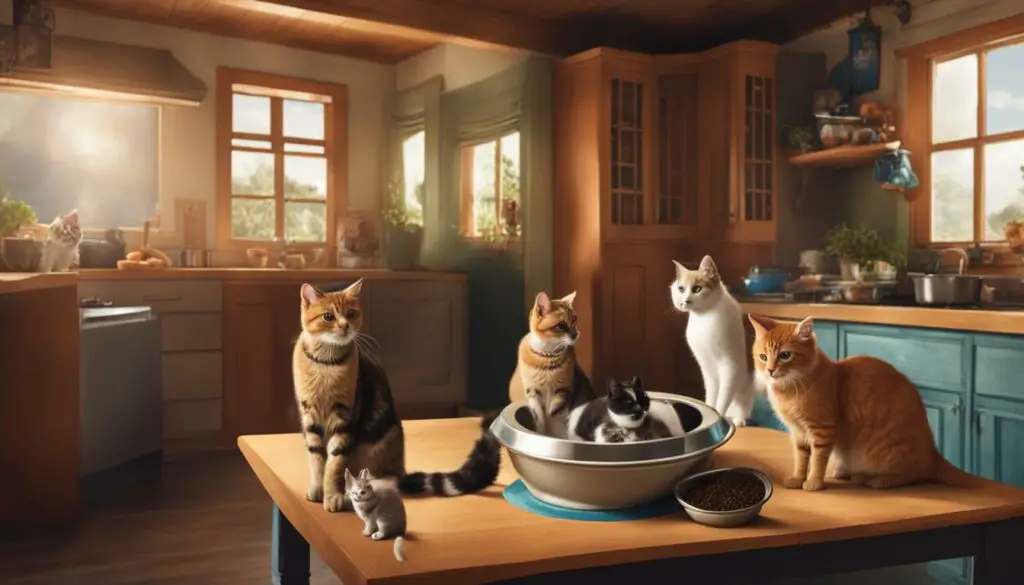
Attention to Hygiene
When dealing with a cat that poops in its food bowl, it is crucial to pay attention to hygiene. Cats are naturally clean animals and may refuse to use a litter box that is not up to their standards. Ensuring that the litter box is cleaned regularly and maintaining pristine litter can help prevent this inappropriate elimination behavior.
| Litter Box Cleanliness | Pristine Litter | Cleaning Routines |
|---|---|---|
| Regularly clean the litter box to remove waste and odor. | Provide fresh, clean litter that meets your cat’s preferences. | Establish a cleaning routine to ensure the litter box remains clean and appealing to your cat. |
| Remove waste promptly to prevent the litter box from becoming dirty and uninviting. | Some cats may have a preference for a certain type or brand of litter, so experiment to find the one your cat prefers. | Clean the litter box at least once a day or more frequently if your cat is particularly sensitive to cleanliness. |
| Use unscented litter to avoid overwhelming your cat’s sensitive sense of smell. | Empty and replace the litter entirely on a regular basis to maintain freshness. |
Ensuring that the litter box is cleaned regularly and using a litter that meets your cat’s preferences can help prevent inappropriate elimination. Some cats have a strong aversion to even a small amount of waste in the litter box, so it is important to maintain cleanliness to encourage proper use.
Remember, cats have high hygiene standards, so maintaining a clean and inviting litter box is key to preventing inappropriate elimination behaviors.
By paying attention to hygiene and providing a litter box that meets your cat’s standards, you can reduce the chances of your cat pooping in its food bowl and encourage proper elimination behavior.
Health Considerations
When it comes to inappropriate elimination, health issues should never be ruled out. Constipation, diarrhea, and painful or fear-related incidents can all contribute to a cat pooping in its food bowl. If a cat has experienced constipation or diarrhea, they may associate the litter box with discomfort and choose to avoid it altogether. Similarly, if they have had painful incidents or feel fearful while using the litter box, they may seek alternative places to eliminate.
It is essential to consult a veterinarian if there are concerns about the cat’s health. A veterinary consultation can help determine if there is an underlying medical condition that needs to be addressed. Conditions such as urinary tract infections, gastrointestinal disorders, or anal gland issues can all contribute to inappropriate elimination behaviors. By seeking veterinary attention, potential health issues can be identified and treated, helping to alleviate the inappropriate pooping behavior.
Regular veterinary check-ups are also crucial for monitoring a cat’s overall health and preventing future instances of inappropriate elimination. These check-ups allow veterinarians to detect any potential health issues early on, providing the opportunity for prompt intervention. By staying on top of preventive care and addressing any health concerns promptly, cat owners can help ensure their feline companions’ well-being and minimize the occurrence of inappropriate pooping behaviors.
| Health Considerations | Symptoms | Action |
|---|---|---|
| Constipation | Straining to defecate, dry or hard stools, reduced appetite | Consult a veterinarian for diagnosis and treatment |
| Diarrhea | Loose or watery stools, increased frequency of bowel movements | Consult a veterinarian for diagnosis and treatment |
| Pain or Fear-related Incidents | Vocalization during elimination, avoiding the litter box | Consult a veterinarian for diagnosis and treatment |
Remember, if a cat is pooping in its food bowl, it is crucial to consider the possibility of underlying health issues. Veterinary consultation can help identify and address any medical conditions that may be contributing to the behavior. By prioritizing a cat’s health and seeking professional advice when necessary, cat owners can work towards resolving inappropriate elimination behaviors and promoting their cat’s overall well-being.
Additional Resources:
- ASPCA: Litter Box Problems
- Cornell Feline Health Center: Feline Health Topics
- Human Society: Cat Marking: Urine Spraying and Scratching

Troubleshooting Tips
When dealing with a cat that poops in its food bowl, there are several troubleshooting tips that can help address and prevent this behavior. By following these tips, you can create an environment that encourages appropriate litter box use and reduces the likelihood of your cat pooping in its food bowl.
Clean the litter box daily
One of the most important steps in preventing inappropriate elimination is to clean the litter box daily. Cats are clean animals and may refuse to use a dirty litter box. By regularly scooping out waste and replacing soiled litter, you ensure that the litter box remains clean and appealing to your cat.
Set up temporary litter boxes
If your cat is particular about litter preferences, you can set up temporary litter boxes with different brands or types of litter. This allows you to identify the litter that your cat prefers and may encourage it to use the litter box instead of the food bowl.
Adjust the location of the litter box
The location of the litter box can also play a role in your cat’s litter box usage. Make sure the litter box is placed in a quiet and easily accessible area that your cat feels comfortable in. Avoid placing it near noisy appliances or in areas where there is a lot of foot traffic.
Use enzymatic cleaners
If your cat has previously pooped in the food bowl or other inappropriate locations, it is important to thoroughly clean those areas with enzymatic cleaners. These cleaners help break down the enzymes in the feces, eliminating any lingering odors that may attract your cat to return to those spots.
By following these troubleshooting tips and implementing appropriate litter box practices, you can help prevent your cat from pooping in its food bowl. However, if the behavior persists or worsens, it is recommended to consult a veterinarian or an animal behaviorist for further guidance and support.
Importance of Regular Veterinary Check-ups
Regular veterinary check-ups are crucial for the overall health and well-being of your cat. These check-ups provide an opportunity for health monitoring, preventive care, and early detection of any potential health issues. By regularly visiting the veterinarian, you can ensure that your cat receives the necessary vaccinations, screenings, and treatments to maintain optimal health.
During a veterinary check-up, your veterinarian will perform a thorough examination of your cat, including checking their weight, heart rate, and overall body condition. They may also conduct blood tests, urine tests, or other diagnostic procedures to assess your cat’s internal health. These tests can help detect any underlying medical conditions or diseases at an early stage, allowing for prompt treatment and management.
Preventive care is an essential aspect of regular veterinary check-ups. Your veterinarian will be able to provide guidance on nutrition, parasite prevention, dental care, and other preventive measures to keep your cat healthy. By implementing these preventive measures, you can minimize the risk of your cat developing certain diseases or conditions.
Early detection of health issues is another significant benefit of regular veterinary check-ups. Cats are masters at hiding signs of illness, and sometimes it can be challenging to recognize subtle changes in their behavior or appearance. During a check-up, your veterinarian can identify any potential red flags and recommend further diagnostic tests or treatments. This early detection can significantly increase the chances of successful treatment and improve your cat’s prognosis.
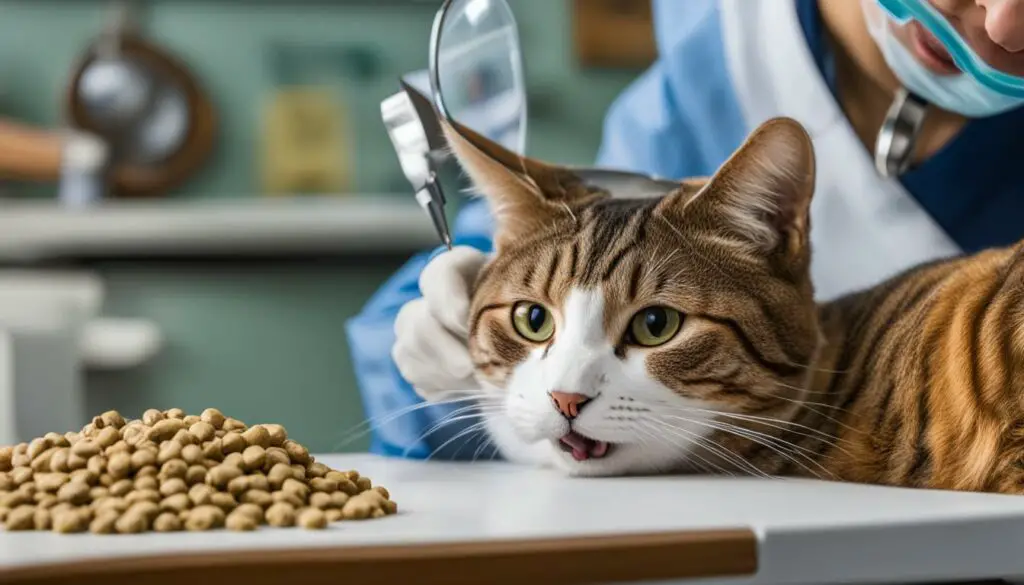
The Benefits of Regular Veterinary Check-ups:
- Health monitoring to detect potential issues
- Preventive care to keep your cat healthy
- Early detection of health problems for prompt treatment
In conclusion, regular veterinary check-ups are essential for ensuring the well-being of your cat. These check-ups provide health monitoring, preventive care, and the early detection of any potential health issues. By prioritizing regular veterinary visits, you can give your cat the best chance at a long and healthy life.
Seeking Professional Help
If you have tried various preventive measures but your cat’s inappropriate pooping behavior persists, it may be time to seek professional help from an animal behaviorist. A behavior consultation with an expert can provide valuable insights into the underlying causes of the behavior and offer behavior modification techniques tailored to your cat’s specific needs. A behaviorist will assess your cat’s environment, health, and behavior history to develop a customized plan to address the issue.
During a behavior consultation, you can expect the behaviorist to ask in-depth questions about your cat’s behavior, medical history, and the household environment. They may also observe your cat’s behavior in person or through video recordings to better understand the problem. Based on their assessment, the behaviorist will provide you with practical strategies and techniques to modify your cat’s behavior.
Behavior modification techniques may include:
- Implementing positive reinforcement techniques to encourage desired behaviors
- Creating a structured routine and environment to reduce stress
- Introducing environmental enrichment activities to keep your cat mentally stimulated
- Addressing any underlying medical conditions that may be contributing to the behavior
Remember that each cat is unique, and what works for one may not work for another. It’s essential to be patient and consistent with the behavior modification techniques recommended by the behaviorist. With time and proper guidance, you can help your cat overcome their inappropriate pooping behavior and create a harmonious living environment for both of you.
| Behavior Modification Techniques | Description |
|---|---|
| Positive Reinforcement | Using rewards, such as treats or praise, to reinforce desired behaviors and discourage inappropriate pooping. |
| Environmental Enrichment | Providing a stimulating environment with toys, scratching posts, and interactive play to keep your cat mentally and physically engaged. |
| Structured Routine | Creating a consistent daily routine for feeding, playtime, and litter box maintenance to reduce stress and anxiety. |
| Addressing Medical Issues | Working closely with your veterinarian to rule out any underlying medical conditions that may be contributing to the behavior, and treating them accordingly. |
Seeking professional help from an animal behaviorist can be a valuable investment in your cat’s well-being. By collaborating with an expert, you can gain a deeper understanding of your cat’s behavior and learn effective techniques to modify their inappropriate pooping behavior. Don’t hesitate to reach out to a qualified behaviorist to provide the support and guidance you need on this journey.
Tips for Cat Owners
As a cat owner, there are several proactive steps you can take to prevent inappropriate pooping behaviors and ensure a harmonious relationship with your feline companion. Resource management is essential when it comes to preventing competition between cats. Provide each cat with their own food bowl, water bowl, and litter box to minimize conflicts and territorial disputes.
Stress reduction is another key aspect of maintaining healthy litter box habits. Environmental enrichment, such as interactive toys and scratching posts, can help alleviate stress and provide mental stimulation for your cat. Additionally, maintaining a calm and consistent daily routine can help reduce anxiety and promote proper toilet behavior.
Litter box maintenance is crucial in preventing inappropriate elimination. Clean all litter boxes daily to ensure they meet your cat’s high standards of hygiene. Some cats may even require pristine litter, so it’s essential to keep the litter boxes fresh and free of waste. Regularly monitor the litter box location and ensure it is in a quiet and accessible area to prevent your cat from searching for alternative elimination spots.
Table: Tips for Preventing Inappropriate Pooping Behaviors
| Resource Management | Stress Reduction | Litter Box Maintenance |
|---|---|---|
|
|
|
By implementing these tips and addressing any changes promptly, you can help prevent the recurrence of inappropriate pooping behaviors in your cat. However, if the issue persists despite your efforts, it may be necessary to seek professional help from an animal behaviorist who can provide tailored guidance and behavior modification techniques.
Conclusion
Inappropriate elimination behaviors, such as finding your cat pooping in its food bowl, can be frustrating for cat owners. However, understanding the underlying causes is crucial in order to effectively address this issue. By considering factors such as marking behavior, territorial disputes, litter box preferences, environmental factors, and health issues, you can take proactive steps to prevent and manage this behavior in your feline companion.
If your cat is pooping in the food bowl, it is important to rule out any potential medical issues. Consult a veterinarian to ensure that there are no underlying health concerns causing this behavior. Additionally, take into account your cat’s litter box preferences, keeping it clean and providing the appropriate size and type of litter they prefer.
Environmental factors, such as changes in the household or stressors, can also contribute to inappropriate elimination. Take steps to reduce stress and provide a calm and enriching environment for your cat. If there are multiple cats in the household, make sure each cat has their own resources to minimize conflicts.
If you have tried preventive measures and the behavior persists, seeking professional help from an animal behaviorist can provide valuable insights and behavior modification techniques tailored to your cat’s specific needs. By taking proactive steps and addressing the underlying causes, you can help prevent and manage inappropriate pooping behaviors in your beloved feline friend.
FAQ
Why is my cat pooping in its food bowl?
Cats may poop in their food bowl for various reasons, including marking behavior, territorial disputes, or illness. It is recommended to consult a veterinarian to rule out any health issues.
How can I prevent my cat from pooping in its food bowl due to marking behavior?
To prevent marking behavior, increase the number of resources available to your cat, provide separate food and water bowls, and ensure a calm and stress-free environment.
What should I do if my cat’s pooping in the food bowl is a result of illness?
If your cat is exhibiting other symptoms such as urinating outside the litter box or showing signs of distress, it is crucial to seek immediate veterinary attention to address any underlying health issues.
How can I address litter box-related factors that may be causing my cat to poop in its food bowl?
Ensure that the litter box is the appropriate size, clean it regularly, and provide litter box training for your cat.
Can environmental factors contribute to my cat pooping in its food bowl?
Yes, changes in the house or daily routines can cause stress and lead to inappropriate elimination. Consider these environmental factors when addressing the issue.
How can I accommodate my cat’s scent and sensory preferences to prevent it from pooping in its food bowl?
Avoid offensive smells, provide a quiet and pleasant location for the litter box, and choose a litter that suits your cat’s preferences.
What can I do to reduce anxiety and stress in my cat and prevent it from pooping in its food bowl?
Implement anxiety-reducing techniques, such as providing hiding spots, interactive toys, and a calm environment, to help reduce stress and prevent inappropriate elimination.
How can I manage multi-cat dynamics to prevent my cat from pooping in its food bowl?
Ensure each cat has access to its own resources, such as food and litter boxes, and provide enough litter boxes to reduce inter-cat dynamics and stress.
How important is hygiene in preventing my cat from pooping in its food bowl?
Maintaining a clean litter box and using a litter that meets your cat’s preferences can help prevent inappropriate elimination. Some cats require pristine litter.
Can health issues contribute to my cat pooping in its food bowl?
Yes, if your cat has experienced constipation, diarrhea, or painful incidents while using the litter box, it may associate the box with discomfort and avoid using it. Consult a veterinarian to rule out any medical conditions.
What troubleshooting tips can help address my cat’s pooping behavior?
Clean all litter boxes daily, set up temporary litter boxes with different brands, adjust the location of the litter box, and use enzymatic cleaners to discourage the behavior.
How important are regular veterinary check-ups in preventing my cat from pooping in its food bowl?
Regular veterinary check-ups are essential for maintaining your cat’s overall health and addressing any underlying medical conditions that may contribute to inappropriate elimination.
When should I seek professional help for my cat’s inappropriate pooping behavior?
If the behavior persists despite preventive measures, it may be necessary to seek professional help from an animal behaviorist who can provide insights into the underlying causes and offer behavior modification techniques.
What tips can help cat owners prevent inappropriate pooping behaviors?
Manage resources such as food and litter boxes, reduce stress through environmental enrichment, and maintain proper litter box hygiene. Regularly observe your cat’s behavior and address changes promptly.
How can I conclude inappropriate pooping behaviors in my cat?
By considering factors such as marking behavior, territorial disputes, litter box preferences, environmental factors, and health issues, cat owners can prevent and manage inappropriate pooping behaviors in their feline companions.

